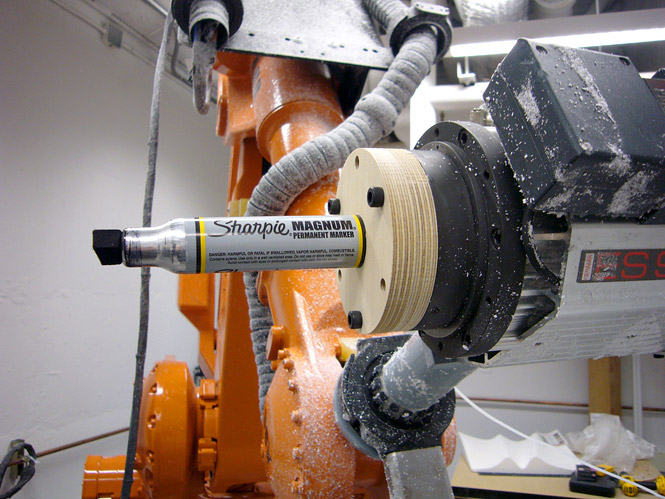All of the fun of the ongoing intellectual property debate now packaged in convenient glove form.
Gain maximum web credibility with FOXBLING.
Picture: Mozilla Legend Chris Hoffman, Nadine Freischlad, TBX, Sarah and Mozilla Evangelism Lead Chris Blizzard
 Photo by Evan Roth
Photo by Evan Roth
As seen in Berlin at the “Skate The Web” exhibit, at the “BLK River Festival” in Vienna and soon at Transmediale Berlin, SA, Feb.06 6 pieces edition 8cm + 6 pieces edition 4cm. Shoot me an email if you want one.
Of course, the vector file for laser action is “open source” and available on thingiverse.com/thing:1609
Special greetz to my homie “Laser” Martin Bauer of lasernlasern.de
000000book.com (“Blackbook”) is a new website for archiving and sharing motion-captured graffiti tags. Tags are saved as Graffiti Markup Language (GML) files, which can be created with freely available software like Graffiti Analysis, Laser Tag, and with our two new iPhone apps, DustTag and FatTag Deluxe: Katsu Edition.
Anyone can easily upload GML to #000000book through our open API, and the aforementioned iPhone apps have 000000book.com upload built-in — download the app, start tagging, tap ‘upload’, and see your work immediately featured on the frontpage.
By registering on #000000book you can link your iPhone (or any other device) and your uploads will be automatically added to your account. While browsing the site you can also mark tags as ‘favorites,’ and leave comments/talk shit. And each user has a profile page that shows off their bling:
For example: Tempt1 uploads tags from his EyeWriter in LA, and Katsu and AVONE have been uploading some dope tags from their phones:

Katsu vs. James Cameron, created with FatTag Deluxe
Programmers & artists can then download your GML data and render the tags in any conceivable way, shape, or form. Since our launch last week we’ve already seen a number of amazing GML-based projects:
* Robotagger draws graffiti tags with an 8-foot robotic arm (seriously)
* Baybayin Motion Analysis uses GML to capture & study a pre-Filipino writing system
* Experimental Flash 3D Renderer (Flash) by Ben Hopkins (Kode80)
* GML particle system rendering (Flash) by DIZGID
Developers: we’re compiling API documentation to get you started pulling in GML and/or uploading your own data, as well as sample drawing code for Flash, C++, Javascript and more. Discussion & brainstorming is happening on our mailing list and in #fatlab IRC
Make sure to submit any applications you create — if it runs inside a web browser (e.g. Flash, Javascript or Processing) it can even be used by #000000book visitors to preview tags!

A labor-saving device for graffiti artists. An assistive tool or telematic proxy for taggers working in harsh environments. Long-needed relief for graffiti artists with RSI. Or simply, pure research into as-yet-untrammeled intersections of automation and architecture. We give you: the ROBOTAGGER, an industrial robot arm programmed with GML, the new “Graffiti Markup Language” created by Evan Roth and pals at the FAT Lab.
This quick project came together over the past weekend in CMU’s Digital Fabrication Laboratory (dFAB), directed by my pal, Professor Jeremy Ficca. Inspired by a tweet from Evan Roth, one of the co-creators of GML, we reckoned it would be easy to transcode GML into a file format suitable for robotic CAD/CAM machining. The result is a small Processing utility that converts GML into DXF and CSV (you can download the GML-to-DXF source code here). After tinkering around for a while we developed a pipeline for converting the GML/DXF strokes from 000000book.com into machining paths for the dFAB’s ABB IRB-4400, an eight foot tall industrial robot arm. One of our first tags, which you can see in the video, was made from GML produced by TEMPT ONE (Tony Quan), a graffiti writer with Lou Gehrig’s disease who produced the GML recording with the FAT Lab’s well-known EyeWriter software. Although there’s been a lot of data loss and translation along the way, it’s not completely unreasonable to think of the Robotagger as a prosthesis for Tony. I hope we can pursue this possibility a little further.
Speaking of future directions, there are lots of interesting research topics latent here in automated calligraphy. We were astonished to realize just how important the force-feedback of pressure is to the visual quality of the drawings. (The first 20 seconds of the video shows what I mean in an extreme way – we shattered a marker and sent ink everywhere when our estimate of the Z-plane turned out to be off by a quarter-inch. Looks like we need to get that force-measuring software extension that ABB sells.) Going forward, we’re interested in exploring robotic performances of higher-dimensional gesture data, such as that produced by Wacom tablets, which provides high-resolution information about the pressure, azimuth and elevation (yaw and pitch) of the tagger’s stylus. Watch this space — I’ll be developing some tools to help the next version of GML encode this information.
The Robotagger is a collaboration of Jeremy Ficca’s dFAB at CMU; the STUDIO for Creative Inquiry at Carnegie Mellon, which I direct; and the FAT Lab’s GML initiative. We used the Sharpie Magnum and the wonderful 2-inch Montana Hardcore markers, which (AFAIK) are the largest magic markers in commercial production. (And of course, for the deep history of prior work blending graffiti and automation, don’t forget to check out the spraycan-enabled Graffiti Writer robot [1998-2000] by the Institute for Applied Autonomy, and Jürg Lehni’s wall-spraying Hektor robot [2002].) [Extra link: RoboTagger on Youtube]


The expressions published in this site are all in the public domain. You may enjoy, use, modify, snipe about and republish all F.A.T. media and technologies as you see fit.









